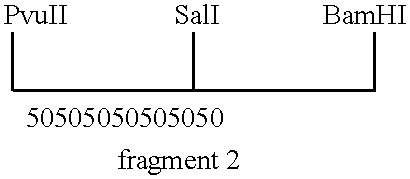Pseudorabies virus protein
a technology of pseudorabies virus and protein, which is applied in the field of recombinant dna molecules comprising dna sequences encoding polypeptides, can solve the problems of errors in the sequence published by rea et al, disease fatality, and inability to produce a vaccine to prevent infection
- Summary
- Abstract
- Description
- Claims
- Application Information
AI Technical Summary
Problems solved by technology
Method used
Image
Examples
example 1
In this example we set forth the sequencing, cloning and expression of PRV glycoprotein gp50.
1. Sequencing of the gp50 Gene
The BamHI 7 fragment of PRV Rice strain DNA (Chart D) which encodes the gp50 gene is isolated from pPRXhl [NRRL B-15772], supra., and subcloned into the BamHI site of plasmid pBR322 (Maniatis et al., supra.).
Referring now to Chart E, the fragment is further subcloned using standard procedures by digesting BamHI 7 with PvuII, isolating the two BamHI / PvuII fragments (1.5 and 4.9 kb) and subcloning them between the BamHI and PvuII sites of pBR322 to produce plasmids pPR28-4 and pPR28-1 incorporating the 1.5 and 4.9 kb fragments respectively (see also, Rea et al., supra.). These subclones are used as sources of DNA for DNA sequencing experiments.
Chart F shows various restriction enzyme cleavage sites located in the gp50 gene and flanking regions. The 1.5 and 4.9 kb fragments subcloned above are digested with these restriction enzymes. Each of the ends generated by t...
example 2
In this example we set forth the protection of mice and swine from PRV challenge using the gp50 of Example 1 as an immunogenic agent.
In Tables 1-3, infra, the microneutralization assay was done as follows: Serial two-fold dilutions of serum samples were done in microtiter plates (Costar) using basal medium Eagle (BME) supplemented with 3% fetal calf serum and antibiotics. About 1000 pfu (50 .mu.l) of PRV were added to 50 .mu.l of each dilution. Rabbit complement was included in the virus aliquot at a dilution of 1:5 for the mouse serum assays but not the pig serum assays. The samples were incubated for either 1 hr (swine sera) or 3 hrs (mouse sera) at 37.degree. C. After the incubation period, an aliquot (50 .mu.l) of porcine kidney-15 (PK-15) cells (300,000 cells / ml) in Eagle's Minimum Essential Medium was added to each serum per PRV sample. The samples were subsequently incubated at 37.degree. C. for 2 days. Neutralizing titers represent the reciprocals of the highest dilutions wh...
example 3
In this example we set forth the isolation, cloning and sequencing of the gp63 and gI genes.
1. Library Construction
PRV genomic DNA was prepared as described previously (T. J. Rea, et al., supra.). Fragments of 0.5-3.0 kb were obtained by sonicating the PRV genomic DNA of the PRV Rice strain twice for 4 sec each time at setting 2 with a Branson 200 sonicator. After blunt ending the fragments with T4 DNA polymerase, the fragments were ligated to kinased EcoRI linkers (T. Maniatis, et al., supra). After over-digestion with EcoRI (since PRV DNA does not contain an EcoRI site, methylation was unnecessary), excess linkers were removed by agarose gel electrophoresis. The PRV DNA fragments in the desired size range were eluted by the glass slurry method, (B. Vogelstein and D. Gillespie, Proc. Natl. Acad. Sci. USA, 76, pp. 615-19 (1979)). A library of 61,000 .lambda. / PRV recombinants (.lambda.PRVs) was constructed by ligating 500 ng of PRV DNA fragments to 750 ng of EcoRI digested .lambda.gt...
PUM
| Property | Measurement | Unit |
|---|---|---|
| molecular weights | aaaaa | aaaaa |
| optical density | aaaaa | aaaaa |
| pH | aaaaa | aaaaa |
Abstract
Description
Claims
Application Information
 Login to View More
Login to View More - R&D
- Intellectual Property
- Life Sciences
- Materials
- Tech Scout
- Unparalleled Data Quality
- Higher Quality Content
- 60% Fewer Hallucinations
Browse by: Latest US Patents, China's latest patents, Technical Efficacy Thesaurus, Application Domain, Technology Topic, Popular Technical Reports.
© 2025 PatSnap. All rights reserved.Legal|Privacy policy|Modern Slavery Act Transparency Statement|Sitemap|About US| Contact US: help@patsnap.com



